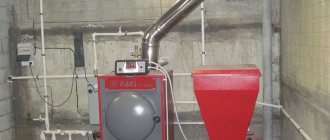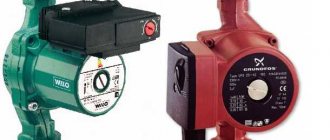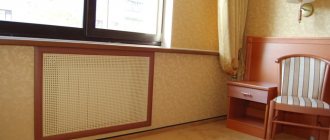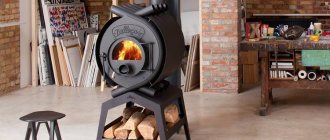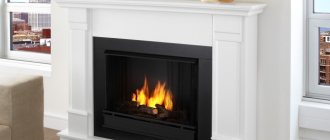The construction of greenhouses and sheds, the laying of utilities - all this requires a bent metal profile. But buying pipes bent to order is expensive, and purchasing a ready-made pipe bender is also not a cheap pleasure. So modern craftsmen use devices and self-made mechanisms to create metal arcs of the required radius.
In this article we will consider the following questions:
- Types of homemade pipe benders and their features.
- The design of the simplest device for bending square pipes.
- Design of a three-roll machine for bending round and square pipes.
- Technology for bending pipes using a three-roll homemade pipe bender.
Design and principle of operation of a manual pipe bender
A manual pipe bender is quite simple in design and operating principle, so a home craftsman can easily handle its manufacture on his own.
The main elements in any pipe bending device is the pressure plate. A special mechanism presses on it with a certain force, and it transmits the force to the pipe being processed. To perform bending, the corrugation is installed between the pressure plate and several shafts, which act as stabilizers. Also, with the help of shafts, you can adjust the bending radius, since their position is adjustable.
So, to bend a pipe along a small radius, the shafts are placed fairly close to each other, and if it is necessary to increase the radius, then they are moved further away from each other.
The main elements in pipe benders are crescent-shaped shafts
To bend a round pipe, crescent-shaped shafts are installed on pipe benders.
Manual device
A homemade manual pipe bender, which is used to bend round pipes, consists of two machined pulleys, one of which is fixed motionless, and the second rotates around the first at a distance of the diameter of the pipe being processed. The principle of its operation is simple: a pipe is placed between two pulleys and by rotating the movable pulley, the round pipe is bent to the desired angle.
A manual pipe bender in the hands of a skillful owner may be needed at any time, therefore it is worthwhile to approach its manufacture thoroughly, so that it can bend pipes of various diameters.
This design will require two triple pulleys instead of single pulleys: one pair will be used for bending 1/2″ pipe, one for bending 3/4″ pipe, and one for inch pipe.
It is unlikely that you will be able to buy such devices on the market, so you will need to order them from a turning workshop. A recess is made at the ends of the shafts, which in size coincides with half the diameter of the corrugation.
A manual pipe bender consisting of two pulleys, one of which is fixedly fixed
Another important point that needs to be taken into account when manufacturing shafts is that the stationary pulley should be minimal in size, since the minimum possible bending radius of the product depends on this. The optimal size of the moving shaft is twice the diameter of the stationary one.
Stationary pipe bender step by step instructions
If you plan to make your own greenhouse from steel pipes, then you will need to acquire not just an ordinary pipe bender, but a reliable product. After all, with this approach you will need to bend more than a dozen profile pipes. To make the greenhouse design neat and beautiful, you need to use a stationary pipe bender.
Before you start making a greenhouse, you need to make sure that you have the appropriate tool for bending profile products. The following elements will be needed to construct a stationary pipe bender:
- rod at 25;
- 6 bearings;
- channel.
You will also need a welding machine, which will be used to connect all the components. Step-by-step instructions for making a stationary pipe bender are as follows:
- Bearings are welded to the base (channel), which are connected to each other by a shaft in the form of a steel pipe of the appropriate diameter.
- To prevent the shaft from being located too close to the base, the bearings should be welded onto 5 cm pieces of rectangular pipe.
- In order to deliberately produce a unit with which the bending radius could be adjusted, the base must be made of two channels connected to each other by curtains, as can be seen in the photo above.
- Two shafts with bearings are located at the same height, and the third (central) is welded using a rectangular tube 15-20 cm higher.
- An additional tube needs to be welded to the upper shaft, to which the handle will be attached. This shaft will be driven by muscular force.
- The handle is welded to the upper shaft, after which the resulting product can be checked for functionality.
When installing a profile tube of any size, you should adjust the radius of the final bend. This can be done using a jack located under the base on which one of the shafts is fixed. Having adjusted the required bending radius, the handle rotates. The result is high-quality curved tubes. The advantage of a pipe bender is the ability to bend materials of any size and diameter.
Among the disadvantages, we can only note the possibility of operation in one place
It is important to understand that such a device can be used for any need. To manufacture such a device, an investment of no more than 500 rubles will be required.
You only need to buy 6 bearings, and all the other elements can be found in every craftsman’s household.
DIY pipe bender photo
Operating rules
If I use a homemade pipe bender or a purchased model, I must adhere to the operating rules:
- Check how the rollers are positioned before starting work.
- Do not try to bend pipes with large wall thicknesses using homemade equipment.
- If you need to bend a seam pipe, the seam should be directed towards the bend. Otherwise it will lead to pipe rupture.
If you try to bend a pipe made of a high-strength alloy without heating, the following defects may appear:
- On the outside of the bend, the wall thickness decreases.
- Wrinkles appear on the inside after bending.
- The form is distorted. From cylindrical it turns into oval.
To eliminate the risk of such defects, it is necessary to use a mandrel. This is a special device that is located inside the pipe at the bend. It can be flexible or rigid. When the technological process is completed, the mandrel is pushed out. The shape of the product remains unchanged.
How to make different types of pipe benders?
The principle of operation of pipe benders is different - you can influence a section of pipe in different ways. For example, a spring-type device will help deform polymer pipes due to pressure. Segmental devices will stretch them, giving them curvature.
The method of making a template pipe bender is accessible even to a beginner. To do this, you need to accurately draw a part of a circle of the required diameter (or other type of curvature). This hemisphere or other curve is drawn on a wooden blank, as in the photo of a homemade template-type pipe bender.
The resulting part must be fixed on a stable base along the plane (wall, table).
After the template stop is ready, you need to figure out how to use a pipe bender of this type. This is clear from the drawing - the pipe is secured between the template and the thrust beam.
By exposing the opposite end to a heated aluminum or thin steel billet, the desired bend is obtained. If it is necessary to obtain segments of different curvature, several suitable templates are made.
Pipe bending methods
There are several options for bending pipes:
- Winding method.
- Run-in method.
- Bending through three rollers.
- Drawing method.
- Bending using two supports, a load.
- Application of hydrostatic pressure.
- Bending using copiers.
In addition to the presented methods, there are two main bending technologies. Hot - this technology is used for bending pipes without the use of pipe benders. They are heated from the outside and inside using filler (river sand). Cold - used for bending ductile metals.
Make your own crossbow pipe bender with a punch
They are called pipe bending machines because of their similarity with a type of weapon such as a crossbow. Only instead of arrows, a hydraulic jack is used, acting on the profile or pipe, bending them. To construct a crossbow-type pipe bending machine, you will need to use a welding machine. To implement the idea you will need to perform the following steps:
- A frame of a cone-shaped design is manufactured. For this, corners, channels, profiles, etc. are used.
- Two steel plates are connected using movable rollers, through which the part is bent
- Inside between the rollers there is a jack on which a C-shaped shoe or punch is placed
- The shoe must have grooves to prevent the tube or profile from slipping
This is interesting!
You can buy a punch or make it yourself.
For manufacturing, you will need a tube from which the seat for the material to be bent is made. It is recommended to use such pipe benders for bending pipes, since other shapes of products will simply be deformed using such a machine. It is not difficult to make such a device, but you will need a hydraulic jack for this.
The video below shows how to make a crossbow pipe bender on your own.
https://youtube.com/watch?v=YoG0d5OqeCc%3F
Frame design
Having decided on the center distance and the design of the rollers, you can mark the blank parts for the frame. Based on the experience of FORUMHOUSE users, it should be concluded that the strongest frames are made from steel channels (at least 80 mm wide). This material is easy to get, so you can safely take note of it.
The photo shows the machine at the manufacturing stage. And here is the drawing that is taken as a basis.
Person User FORUMHOUSE
During the work, some changes were made to the original drawings.
The presented drawing is not a mandatory guide to action, but provides an objective understanding of how a rolling pipe bending machine works.
How to make rollers for a pipe bender
Difficulties often arise with making homemade pipe benders, and the main problem is how to make the rollers. To make rollers for a pipe bending machine, you will need to use the following parts:
- Bearings are an ideal option, as they have an inner and outer race, through which the part can be secured to the base. Bearings are used for the manufacture of roller pipe bending machine
- Rollers, for example, a tensioner pulley from a car. Round rollers are used for the manufacture of machines with a clamping mechanism. A tensioner roller from a car is used as a break-in tool.
- Car hubs are a good option for making movable rollers. Below is an example of making a machine for bending pipes from car hubs
To make rollers on a rolling machine, it is necessary to use bearings of the appropriate diameter, as well as a steel tube. The manufacturing principle is as follows:
- Two bearings are connected to each other by means of a steel tube, the diameter of which is equal to or less than the internal hole of the part
- The steel tube is welded to the inner race of the bearings, resulting in a finished roller
- The outer race of the bearing is secured to the base of the machine using a weld seam
The result is reliable rollers for the pipe bender, through which the pipe moves when it is deformed.
Types of pipe bending devices and mechanisms
Nowadays, you can find examples of pipe bending equipment that have different designs: from relatively simple devices for manual bending to homemade machines with manual or electric drive.
According to their purpose, pipe benders are divided into two types.
The first type is angular (they allow you to give the desired radius to a certain area of the workpiece).
The second type is three-roll pipe benders - machines and devices that allow you to form a given bending radius along the entire length of the workpiece.
Depending on the method of adjusting the radius, pipe benders are mechanical.
And hydraulic.
The support shaft drive can be either manual or electric.
Main rules
The main causes of defects in pipe bending are incorrect (usually too small) bending radius and a short technological shank (“tail”), the distance from the end of the pipe closest to the bend to its beginning. The “tail” is needed not only for reliable fastening of the pipe, the “tail” is also an absorber for the release of technological stresses. A perfectly correct pipe bender can produce a wave or a defect (parasitic bend).
The rules for choosing the bending radius of the pipe RIZG and the length of the technological shank L are summarized in the table:
IZGIZG
- If the difference between the real and the nearest tabulated values of the pipe diameter P is more than 10%, the values of the initial calculated values are calculated by interpolation. Otherwise, we take the nearest one.
- The tabulated RIZG is reduced to the relative value rIZG, i.e. It is expressed in pipe diameters D or heights H.
- For pipes with a diameter of up to 10 mm, 1 is subtracted from rIG.
- For pipes with a diameter of 11 to 15 mm, 0.85 is subtracted from rIG.
- For pipes with a diameter of 16 to 24 mm, 0.75 is subtracted from rIG.
- For pipes with a diameter of 25 to 40 mm, 0.65 is subtracted from rIG.
- For pipes with a diameter of more than 40 mm, 0.5 is subtracted from rIG.
- Convert the relative rIZG back to the numerical (millimeter) RIZG.
- From the obtained value of RIZG, take the nearest practically convenient larger one.
Example: you need to bend 24x24x1.5 from a steel pipe, i.e. already classified as thin-walled, complex semi-arches for a flower house or hut. The structure is non-residential, light, the complex semi-arch is not a load-bearing structure (see below), i.e. "plumbing" wave and taffy are acceptable. We take data for the pipe H=25. According to the table we find rIZG = RIZG/H = 80 mm/25 mm = 3.2. Subtract the correction (for pipe H=25!): 3.2 – 0.65 = 2.55. Convert back to millimeters (again according to the table H=25!): 2.55x25 = 63.75 mm. That is, if we take a new bending radius of 65 mm instead of the “defect-free” 80, then the selection of bending devices and work will be simplified, the possibilities of artistic expression by the shape of the structure will increase, and there will be no visible and/or dangerous defects in the finished structure.
Simple - radius
A specific pipe bender is designed for a bend radius within certain limits. But to select a design prototype, you immediately need to know only its very general meaning:
- for small radii RIZG<5D (or 5H);
- for average radii 5IZG<20 D or H;
- for large radii 20D(H)IG;
Construction of a pipe jack bender
Weld the corners vertically onto the station. Make holes in the channels for installing rollers.
Weld channels onto the corners (2 corners - 1 channel). Place the channels with the platforms facing each other. The spacing between parts should correspond to the length of the rollers. Mount the rollers in the prepared holes and secure with bolts.
How to choose an air conditioner for your home or apartmentDo-it-yourself bait - composition, application features and storage methods (115 photos and videos)
- DIY sliding gates - how to build simple and automatic gates. Schemes, drawings and review of the best ideas (90 photos)
Mount the equipment in the shape of a semicircle on the jack and place it in the central part of the base between the channel structures.
Next, lay the pipe at the bottom of the rollers and press it using a jack. As you press, the pipe will bend into the required position.
Manufacturing of hydraulic machine
This process will be quite labor-intensive. The structure will consist of:
- slats;
- injection device;
- pipe stops;
- hydraulic cylinder.
Before you make a pipe bender yourself, you will need to prepare:
- metal plates;
- rollers;
- channel;
- shoe;
- hydraulic jack.
The latter should be designed for approximately five tons. Initially, the structure is made of a channel, which is equipped with a shoe and rollers. At the next stage, it is necessary to make the frame of the machine from a similar material. The last platform is secured with metal plates. You will need to install a jack on the shelf. The structure is secured with bolts, then the handle is fixed.
If you decide how to make a pipe bender yourself, you must follow special technology. At the next stage, the rollers are installed in a rectangular channel. They are fastened with bolts. The shoe is installed below. These elements will determine the bend radius. At this point we can assume that the machine is ready.
The bending technology will look like this. The pipe must be inserted into the shoe and secured on both sides. Next comes the jack, the handle of which must be slowly rotated. With a hydraulic drive you will create force transmitted to the roller. The product will begin to bend at a certain angle. You can stop the machine at any time.
In order to remove the pipe, you should turn the handle in the opposite direction a few turns. Before you make a pipe bender yourself, you should know that you can change the geometric proportions of such products at home in a variety of ways. But you must choose the most suitable method for yourself. If you don’t plan to do such work on a continuous basis, perhaps sand or freezing techniques will suit you.
Jack pipe bender
A simple and convenient device for bending profile pipes. For production you need the following materials:
- jack;
- 4 corners 40 cm long with equal shelves of 50 mm each;
- 2 rollers with grooves for belts. There should be through holes in the center. If they are missing, drill, measuring the middle;
- equipment for a jack in the shape of a semicircle with a recess inside;
- 2 channels 60 cm long and 10 cm wide;
- bed;
- 2 mounting bolts.
The most popular options for homemade pipe benders
The most technologically advanced and versatile are pipe benders that operate on the rolling principle. It is these devices, often equipped with an electric drive, that are used by professionals who are constantly faced with the need to bend pipes made of various materials, including stainless steel.
Homemade pipe bender option
The design of such a device is based on three rotating rollers, one of which is a pressure roller. Thanks to the gradually increasing pressure of the pressure roller and rolling repeated for each new position of the roller, bending of the pipe is carried out in the most gentle way, its walls are subjected to tensile manipulations very evenly.
Homemade electric pipe bender, made by yourself
Computer model of a pipe bender Computer model of a pipe bender Drawing of a clamping screw Drawings of shafts Drawings of shafts Drawing of a ring Pipe bender components Pipe bender components Assembly process Motor drive Motor drive View from the shafts
The most important thing that such a pipe bender allows you to do is adjust the bending radius of the workpiece. There can be several design options for such a universal device: on the elements of the frame structure there are rotating thrust rollers, as well as a wheel with which the pipe is rolled; The side supporting surfaces and the base are made of sheet metal, and a screw drive is used to move the pressure roller. On devices of the second type, the minimum bending radius can be changed, which is achieved by changing the position of the support rollers.
The shafts of this pipe bender allow you to comfortably work not only with round pipes, but also with profile ones
The supporting structure for such a pipe bender can be made of wood. The roller axles, rod, fasteners and handle for turning the rollers, which can also be made of wood or polymer materials, will remain metal.
Above we looked at pipe benders in which the pulling process is ensured by rotating the pressure roller. There is also a category of devices in which the movement of the pipe is controlled by rotating support rollers.
Option with screw jack
An electric or manual pipe bender, in which rotation is transmitted to one roller, has limited capabilities. A pipe bender in which both support rollers rotate is characterized by a more complex design, since it is necessary to transmit rotation to two elements at once.
More convenient, according to many experts, is a pipe bender in which the pressure roller is located at the bottom. Some craftsmen are of the opinion that it is much easier to control the bending of pipes on it; they are not blocked by the upper supporting structure.
Pipe bender with electric motor and drive via two chains
Any device for bending pipes is a fairly simple device, the operation of which is based on the elementary laws of mechanics. If the need for bending stainless steel, metal-plastic pipes, as well as pipes from other materials arises infrequently, then you can limit yourself to a manual device.
Crossbow pipe bender step by step design instructions
The crossbow bender got its name because it resembles the shape of a hand crossbow. The cost of crossbow devices is about 10 thousand rubles. To save on the purchase of such a unit, it is recommended to make it yourself.
The photo shows two options for crossbow devices for bending pipes. The first option is a factory design, and the second is a homemade machine. The difference between these two machines is significant, since the factory version is made of steel measuring no more than 2 mm, while for the homemade one, metal 3-4 mm thick was used. This means that the homemade unit was made not just to have it, but for everyday use.
Feeling the difference, every master will want to acquire a crossbow pipe bender, making it himself. The disadvantage of this version of the pipe bender is the fact that it allows you to bend the corrugated pipe at only one point. This is due to the fact that the device is equipped with a fixed shoe. This option is used for round pipes when you need to obtain a certain bending radius in one place.
To construct such a device, you need a channel and a hydraulic jack. A special shelf is made for the jack in which it is installed. In the upper working part, two rollers made of steel pipe are mounted between two channels. The distance between the rollers and the heel of the jack must be the same in order to be able to obtain even and neat bends.
What types of devices are there for transforming pipes?
Transforming the curvature of a thin-walled pipe of small diameter is a completely accessible stage in obtaining metal blanks for frame-type structures.
It is enough to look at the drawings and photos of pipe benders, and it will become obvious that structurally they have a lot in common:
- base (support, emphasis);
- frame or frame (open or closed);
- strips, pipe stops or holders;
- screws or vice for fastening;
- injection, mechanical or operating device (alternative power part).
The forming of aluminum, standard steel and metal-plastic pipes can be done using the simplest manual template-type device.
Most pipe benders resemble a compact machine, but they have their own classification:
- by type of impact on pipes (running, winding, drawing, rolling);
- moving if possible (stationary and portable).
The drive type is also different:
- electric;
- manual;
- hydraulic;
- electrohydraulic.
If you use an electric drive or a hydraulic jack, it will take on the entire power load, saving time and effort. But its construction requires at least basic knowledge and experience in constructing household machines for metal processing. But such devices are several times cheaper than ready-made devices and their repeated rental.
The most popular and simplest in design are manual pipe benders of the template type. By bending around a profile or regular pipe along part of its circumference, a section of pipe is transformed at a given angle or the required curvature.
Clamping mechanism
Many craftsmen make a clamp from a regular car jack (mechanical or hydraulic). The forces that it is capable of creating are quite sufficient to give the metal workpiece the desired configuration.
greysv FORUMHOUSE user
I used an old gazelle screw jack as a clamping screw. Easily bends two 20x20 tubes.
If a hydraulic jack is used, it must be rated for 2 tons or more. The main advantage of a hydraulic clamp is that it can be operated without much effort. Advantages of a screw jack: it is easier for them to set the bending radius.
Instead of a mechanical jack, homemade screw clamps are often used. They also allow you to bend workpieces exactly according to specified parameters.
moning
Why is a screw worse than a jack? Order a screw with a smaller thread pitch from a turner so that less effort is applied when rotating. This will cost an order of magnitude cheaper than a jack.
Making a manual roller model
Making a manual pipe bender with your own hands is made from steel parts alone without the use of special mechanical devices. This device is designed for local pipe bending. Direct manual force is used to deform the profile, so the pipe bender must be equipped with a long and strong lever.
Next, we will consider the process of manufacturing a two-roller pipe bender attached to a support frame. Tool sizes may differ from those suggested, depending on needs and materials.
Required materials and tools
Pipe deformation is a labor-intensive process that requires good and durable materials, otherwise, instead of the profile, the working tool itself can be bent.
To make a mechanical manual radial pipe bender you will need:
- Welding machine.
- Two rollers made of durable steel (eg 1045 grade) that have been pre-turned. The diameter of the larger one is 100 mm, and the smaller one is 60 mm. Both are 35 mm thick and have a 0.5 inch outer cavity radius.
- Steel pipe with a diameter of at least 1.5 inches with a thick wall (minimum 3 mm). It will serve as a lever, so its minimum length is 1.5 meters.
- Four steel strips measuring 15 x 6 cm and 4-5 mm thick for fixing the base of the pipe bender in a vice, supporting the pipe and making a handle. You will also need 20-25 cm of steel plate with a width of 60 mm and a thickness of 3 mm.
- Two bolts: the first is 0.75" in diameter and 60mm long for the large roller, and the second is 0.5" in diameter and 40mm long for the small roller.
- Steel plate 300 x 300 mm and a minimum thickness of 3 mm.
- Vise.
During the work process, you may also need other general household tools: a hammer, files, sandpaper, a ruler, etc. The above rollers are designed exclusively for pipes with a diameter of 1 inch, but by eliminating the circumferential recess from them, you can get a universal tool for bending a metal profile.
Materials for volute pipe bender
When making such a pipe bender with your own hands, the dimensions of the parts must be selected to suit individual needs, since this model does not have a specific working diameter. This is also an advantage, since it allows the use of available materials.
To assemble the structure you need:
- meter channel;
- Sheet steel;
- 3 shafts;
- 2 stars;
- steel chain;
- 6 bearings;
- a two-meter pipe with a diameter of 12.7 mm for the production of knobs;
- screw for clamping;
- bushing with internal thread.
Structural elements of a profile pipe bender
Since the energy intensity of the technological operation of bending even high-strength rolled products is small, most of the elements of the pipe bender can be made from ordinary steel of type St.5.
The diameters of the axes of the pipe bender rollers are selected according to the available standard sizes of rolling bearings, and for the base of the rubber clamping jaws, high-strength rubber is used in accordance with GOST 7338-90. The grade of rubber must be at least AMC (weather-oil-resistant), thickness - from 10 mm, degree of hardness - T (this material can withstand pressure from 5 MPa).
Particular attention is paid to forming rollers: they are made by fine turning from tool steel U10 or U12 in accordance with GOST 1435-85. It is necessary to strictly observe the relationship between the executive dimensions of the roller and the cross-sectional dimensions of the workpiece (they are indicated earlier)
The chain drives of the pipe bender and the multiplier can be selected from ready-made parts available in the arsenal of a home craftsman (for a multiplier, for example, a unit used for similar purposes in impact wrenches is suitable).
When assembling, it is worth considering the optimal conditions for lubrication of the rubbing elements, and for ease of use, the handle is made with a corrugated plastic tube.
The frame of the pipe bender can be welded or assembled with bolted joints.
Advantages of copper pipes
Copper pipes are widely used in almost all areas of our activities.
The advantages arise from the characteristics of the metal:
- use for drinking water supply due to bactericidal properties;
- can withstand physical factors (impacts, bends);
- with low service costs and installations have a long service life;
- low cost, which entails cost savings;
- easy to process and install;
- the presence in the retail chain of a huge selection of equipment for copper products, which makes their installation easy;
- absence of any deposits on the metal walls;
- wide temperature range from -200 to +200 degrees, no deformation when changing temperatures;
- good anti-corrosion properties.
Take note: copper pipes have decorative properties and look good in any interior.
Design features of profile benders
As we said earlier, bending machines can differ in what pipes they are intended for: round or profile. The latter, among other things, also allow you to work with other rolled metal: strips and corners.
If pipe benders use rollers with grooves, then conventional shafts can be used in the design of profile bending machines: two support shafts and one pressure shaft. The radius of curvature during the transition must be adjusted manually.
Some even use bicycle bushings as shafts, but they will not withstand heavy loads. Therefore, it is better to rely on round steel timber.
Rollers made from bearings are also often used. You can read how to make a budget profile pipe bender with your own hands in our article.
Pipe bending machines are mostly table-top designs, while profile benders can be either table-top or floor-mounted. The latter are used when it is necessary to bend arcs and half-arcs from long profile pipes.
Types of devices
In order to classify products into various categories, several characteristics are used:
- Drive type – manual, automatic, hydraulic.
- Installation method - portable or stationary.
- Operating principle.
According to the principle of operation, all pipe benders can be divided into several types:
- Winding. The stop is located at the beginning of the bend. Using special clamps, the pipe is pressed against a movable template roller. This roller begins to rotate, passing the pipe between itself and the stop. This is how bending is done.
- Run-in. With this method, the pipe is fixed near a stationary template. The pressure roller begins to rotate around it and gradually bends the pipe to the size of the template.
- Rod or crossbow method. The pipe is fixed between two fixed rollers. Pressure is applied centrally using a template located on the rod. It gradually lowers, bending the pipe in the center between the support posts.
- Rolling (rolling). In this case, pipe rolling involves bending using two rotating support rollers placed along the same line and one central template. The bending radius will depend on the relationship in which these elements are located. As a rule, the pressure on the pipe is exerted by the central roller.
It is worth noting that the first three methods of work have one common drawback - in them, the bending radius of the pipe directly depends on the template.
But the rolling method is used most often to form pipe configurations. Moreover, it is used in industrial enterprises for the production of bends.
What material can the rollers be made from?
It is more expedient to make support and pressure rollers for profile bending (for bending profiles and metal strips) only from steel.
Some people claim that you can use wooden casters (hardwood) or plywood, but this is not true. Such rollers will not last long, although they are much easier to make than steel ones.
Sometimes it is possible to use homemade aluminum rollers with a groove for round pipes. However, here you need to understand that they are also not designed for heavy loads, and cannot replace steel rollers.
When making a homemade pipe bender for a profile pipe, they no longer use rolling pressure rollers, but shafts. They can be made from round steel or bearings. These are the best options.
In general, if you are going to assemble a bending machine yourself (it doesn’t matter - a pipe bender or a profile bender), then it is better to make the rollers or shafts from steel.
Homemade rollers made from other materials do their job worse and quickly become unusable.





